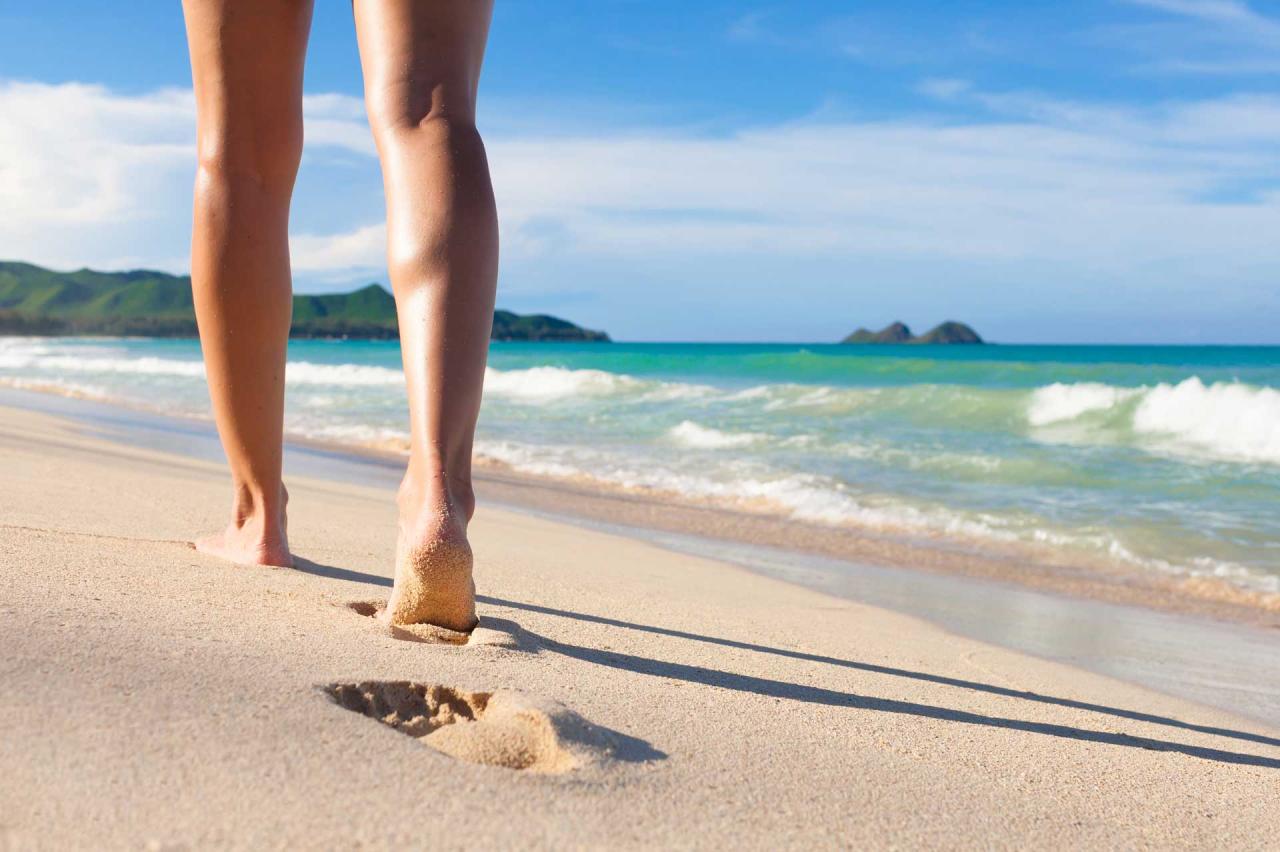Walking on the beach can be more challenging than walking on pavement, grass, or a treadmill due to the uneven terrain and resistance from the sand. However, it offers numerous physical and mental health benefits, making it a healthy and enjoyable form of exercise. Whether you’re a beach resident or on vacation, here’s why beach walking is a great way to stay fit and happy.
Benefits of Walking on the Beach

Enhanced Cardiovascular Health
Walking on the beach is an excellent cardiovascular workout. The soft, uneven sand surface requires more effort from your leg muscles compared to walking on a flat sidewalk. As a result, your heart rate increases, and your cardiovascular system gets a robust workout. This helps improve blood circulation, reduce the risk of heart disease, and lower blood pressure.
Increased Calorie Burn
Walking on sand is more challenging than walking on a solid surface. The instability of the sand forces your muscles to work harder to maintain balance and propel you forward. This increased effort results in a higher calorie burn compared to walking on a flat surface, making beach walking an effective way to manage weight and maintain a healthy body composition.
Strengthened Leg Muscles
The resistance provided by the sand engages the muscles in your legs, including the quadriceps, hamstrings, calves, and glutes. As you walk on the beach, these muscles are continuously activated to stabilize your body on the uneven terrain. Over time, this can lead to strengthened leg muscles, improved endurance, and enhanced lower-body strength.
Better Balance and Stability
Walking on sand requires constant adjustments to maintain balance, which can help improve your overall stability. The variations in terrain challenge your core muscles, including the abdominals and lower back, as they work to keep you steady. Enhanced balance and stability are particularly beneficial for older adults, as they can reduce the risk of falls and injuries.
Reduced Impact on Joints
Compared to jogging or running on hard surfaces, walking on the beach is gentler on your joints. The sand cushions your steps, reducing the impact on your knees, hips, and ankles. This makes beach walking an ideal choice for individuals with joint pain, arthritis, or those recovering from injuries.
Stress Reduction
One of the most significant benefits of walking on the beach is the profound sense of relaxation it offers. The tranquil environment, soothing sound of the waves, and the beauty of the coastline can instantly reduce stress and anxiety levels. Studies have shown that spending time by the ocean can have a calming effect on the mind, promoting mental well-being.
Mood Enhancement
The combination of physical activity and exposure to natural elements triggers the release of endorphins, often referred to as “feel-good” hormones. These endorphins contribute to an improved mood and reduced symptoms of depression. Beach walking provides an opportunity to connect with nature and experience a sense of tranquility, which can enhance your overall mental outlook.
Vitamin D Absorption
Walking on the beach also allows for sun exposure, which is essential for the body’s production of vitamin D. Vitamin D plays a crucial role in maintaining bone health, regulating immune function, and supporting overall well-being. Just be sure to wear sunscreen to protect your skin from harmful UV rays.
Enhanced Respiratory Health
Breathing in the fresh sea air can have a positive impact on respiratory health. The saltwater breeze is rich in negative ions, which are believed to improve lung function and reduce inflammation. For individuals with respiratory conditions like asthma, beach walking may provide relief and improve breathing capacity.
Connection with Nature
Spending time on the beach allows you to connect with the natural world in a profound way. The rhythmic sound of the waves, the sensation of sand between your toes, and the sight of seagulls flying overhead create a sensory experience that can promote mindfulness and a sense of inner peace.

Tips for Walking on the Beach
- Build Endurance Gradually: Walking on sandy or uneven beach terrain can be challenging, especially if you’re not accustomed to it. Begin with short walks and gradually increase your walking duration to prevent overexertion.
- Stay Hydrated: Beach walks under the sun can be dehydrating. Ensure you drink enough water to stay hydrated during your walk.
- Consider Footwear: While barefoot walks are enticing, some may prefer or require footwear. Water shoes or beach-specific sandals with a thick sole and good grip can provide protection from sharp objects and prevent slipping on wet surfaces.
- Joint Concerns: If you have a history of joint issues, walking on sand can be gentler on your joints. You can use joint support if needed, but the low-impact nature of beach walking can be beneficial.
- Injuries and Foot Conditions: Avoid walking on the beach if you have open wounds or certain foot conditions like plantar fasciitis, unless advised by a doctor. Beach walks can be a valuable addition to your exercise routine, but safety always comes first.
Remember to listen to your body, adapt to your needs, and seek professional guidance if necessary, whether you’re walking on a sandy shore or training in a gym. Beach walking can offer both physical and mental health benefits when done safely.
You Might Also Like
Isometric Exercises Found to Reduce Blood Pressure, Study Says
A recent study published in the British Journal of Sports Medicine has highlighted the significant benefits of isometric exercises, such...
5 Types of Exercise That Can Support You During Menopause
Menopause is a natural phase in a woman's life, and its symptoms can vary widely from person to person. Some...
Nature’s Healing Touch: The Multifaceted Benefits of Spending Time Outdoors
Spending time in nature offers numerous benefits for mental, emotional, and physical health. Unfortunately, our modern, fast-paced, and highly connected...
9 Everyday Habits That Help Relieve Back Pain
When it comes to managing, preventing, and relieving back pain, it's essential to consider the everyday habits that can make...










